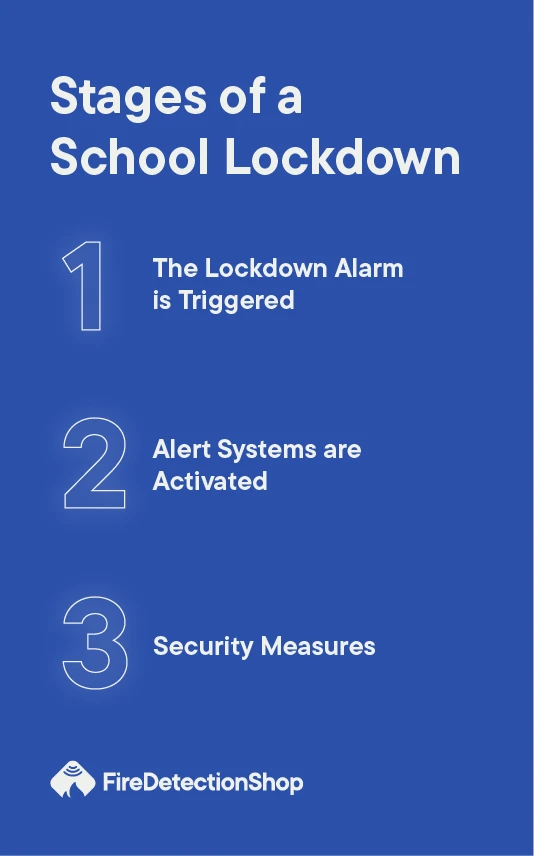08/04/2025 • by Alice P

Educational institutions, such as schools, colleges or universities, have a legal responsibility to ensure the safety of students and staff. While many people understand the importance of fire evacuations, some emergencies require an invacuation or school lockdown.
An invacuation is a safety procedure where people are directed to move into a building or designated safe area to protect themselves from an external threat, such as a terrorist attack, environmental hazard, or other potential dangers outside the building.
Unlike evacuation, where people leave the building to escape danger, invacuation focuses on securing individuals inside the building to keep them safe from an external threat.
A lockdown is an emergency procedure used to keep the building occupants safely inside the premises, preventing unauthorised access from breaking in.
Lockdowns may be implemented to protect students against terrorist attacks, knife crimes or other intruders and invasions. Ultimately, lockdown alarms save lives.
But how would you quickly alert an entire school or college to suddenly start invacuating?
Our security specialists recommend the SiteProtect Lockdown Alarm for communicating and performing lockdowns. However, if you are uncertain about initiating your approach to lockdown alarm systems, please be assured that this article will provide guidance.
A lockdown alarm is a manually operated alarm that audibly alerts others to the presence of an intruder.
Lockdown alarms are an essential part of any security system. Their role is to act as continuous protection against unauthorised access and external threats.
Once manually triggered, the emergency lockdown alarm will activate its flashing beacon and sounder. This keeps others safe by alerting them to act by hiding or securing the building.
If an intruder attempts to break into the premises, your emergency lockdown alarm can be manually operated to provide an immediate alert.
Critical threats that may also require triggering the lockdown alarm include:
Weather hazards such as storms.
Chemical spills, air pollution or environmental hazards like gas leaks.
An individual exhibiting violent or threatening behaviour.
A dangerous animal on school grounds.
But what exactly happens when a lockdown alarm is triggered?
Once danger is detected, your lockdown alarms can be activated manually via a call point. Like fire call point systems, the lockdown alarm system is triggered via a panic button or an emergency switch.
A key aspect of lockdown alarms is that each device is wirelessly connected. This means if one lockdown alarm is triggered, all the devices on the network will activate.
After triggering the lockdown alarm, the devices will emit an audible alarm to alert of the presence of danger.
This alarm may be a siren or a voice command instructing staff and students that a school lockdown is underway and how they are expected to react to the detected danger. Remember, these instructions will vary depending on the institution’s lockdown procedures.
Alongside the audio alert, some lockdown alarms contain a flashing beacon. Beacons will provide a visual cue to alert those with hearing difficulties to the alarm.
Emergency lockdown alarms are typically located in each teaching area. This will ensure the triggered alarm can be communicated directly to staff and students.
After the lockdown alarm has been triggered, staff and students must respond safely. Lockdown procedures will vary depending on the institution. Typically, these actions will include:
Taking shelter or bringing children outside into the building.
Turning off the lights.
Staying silent until the all-clear sign is given.
Staff can take a register to confirm the names of those accounted for. If anyone is absent, the staff may alert the parents or the police.

Lockdown alarms predominantly benefit educational institutions such as schools, colleges or universities.
While the SiteProtect Lockdown Alarm System has been developed primarily for school security, it also defends against invasions in any large public space.
That means lockdown alarms can protect shopping centres by warning of an intruder or other critical events.
Lockdown alarms are important to alert others instantly to danger occurring outside the premises. This may be an intrusion, someone attempting to break in or another external threat that requires a secure lockdown.
Clear Communication: Lockdown alarms are specially designed to contain a sounder and flashing beacon. These features effectively communicate that a lockdown is taking place while keeping information accessible to all.
Fast Response: Reaction time is crucial in an emergency, like an invasion. Once manually activated, lockdown alarms instantly alert others to the presence of danger. This allows people to respond quickly to keep themselves and others safe.
Minimises Panic: In an emergency, confusion can quickly escalate into panic. This panic can potentially cause further harm or put others in danger. The lockdown alarm will minimise this panic, allowing people to respond calmly and safely.
Enhances Security: Lockdown Alarms alert building occupants early to danger, allowing them to respond swiftly by locking doors, alerting police or taking shelter. If an intruder does gain access, these steps will minimise the risk of harm.

The lockdown alarm control panel contacts a responsible person via GSM notifications to notify of an active alarm. This allows the responsible person to quickly identify the location of the activation and alert the police.
The control panel also creates real-time alerts and security notifications to ensure faster responses to developing danger.
Some lockdown alarms have call points which can be activated by the staff member in any area - just like a fire call point system. This gives staff the flexibility to trigger the alarm wherever they are.
The lockdown system can connect to the building’s public address using a SiteProtect interface. This allows a voice message to be broadcast during a lockdown.
An auto dialler is programmed to have a pre-recorded message and a set of numbers to contact in an emergency (an auto dialler can communicate an emergency to up to 50 users).
The auto dialler activates as soon as the lockdown alarm is triggered. While the school lockdown is underway and staff are keeping the students safe, the auto dialler will autonomously contact the police, security team or school administrators.
The autodialler is a crucial part of a lockdown alarm system as it creates proactive security. An autodialler also minimises the risk of panic by ensuring that the right contacts are instantly notified.
The sounder is used to create a loud audio alert. This ensures that staff and students may hear the lockdown alarm throughout the building. This also makes the alarm accessible to those who are visually impaired.
The flashing beacon is specially designed as a visual alert during the lockdown. This feature ensures that those who are deaf can be quickly alerted.
Lockdown procedures are designed to minimise the risk of harm to staff and students in the event of a terrorist attack.
Through a three-step plan, all building occupants can remove themselves from harm and protect themselves until the police arrive or the outside threat has been removed.
Conduct a vulnerability assessment of the school grounds using the ‘traffic light’ system.
This system determines which areas may be the most vulnerable to outside threats and separates them into colour-coded zones. Green zones mean low vulnerability, amber zones mean moderate and red zones are for high vulnerability.
Examining your campus for potential threats may sound daunting, but the process is straightforward. Imagine you are the attacker attempting to gain access.
While conducting this, consider where the easiest places are to gain access. There you will find the most vulnerable areas.
Green zones are considered the least vulnerable and will provide the most protection during a school lockdown.
A space assessment for the green zone must be performed using an approximate calculation of 0.5m² per person. This determines how much space is available for people to use.
Keeping staff and students safe during a school lockdown is not just about how much room they have to hide (although this is an important factor to consider).
Additional factors that are required to keep people safe are:
Access to water and toilets
Easy access to the safe zones
Establishing groups to avoid confusion
Keeping evacuation distances short.
By considering these additional factors, you can minimise panic and reduce the risk of harm.
There are three key things to consider as you construct your lockdown procedure.
Time: A school premises invasion is just as much an emergency as a fire. Like how you need to install fire, smoke and heat alarms to protect schools, emergency lockdown alarms must be installed throughout the school to keep staff and students safe.
The SiteProtect Alarm is an ideal choice. It is fast-acting, easy to retroactively install and distinctly different from fire alarms to avoid any confusion. These lockdown alarms should be fitted in the red zones to maximise the scope and accessibility of protection.
Control: Danger, whether this is a fire or unauthorised access, must be dealt with proactively to ensure staff and students have control over their safety.
The situation must have sufficient management in place, meaning at least three staff members must be allocated the role of incident controller. These staff members should also receive training on how to perform lockdown procedures.
Simplicity: Emergencies cause panic and stress. This makes following lockdown procedures increasingly challenging. Steps should be taken to simplify the lockdown procedures and keep staff and students calm.
We suggest that your fire marshals should also be allocated as incident controllers. When your fire marshals receive training on guiding students out of a burning building, they will also receive training on how to respond during a lockdown.
Lockdown alarms provide an instant and clear alert. These systems enable staff and students to respond swiftly, minimise risk and enhance security.
Investing in emergency lockdown alarms is essential for protecting schools, colleges, universities, and other public spaces from the threat of invasions.
The SiteProtect Lockdown Alarm is a cost-effective solution that adds an extra layer of security to your premises.
At the Fire Detection Shop, our security specialists make safety solutions simple. From our selection of security system equipment, fire safety devices and lockdown alarms, we have the tools and expertise necessary to enhance your safety.

24/07/2025 • by Alice P
29/07/2025 • by Alice P